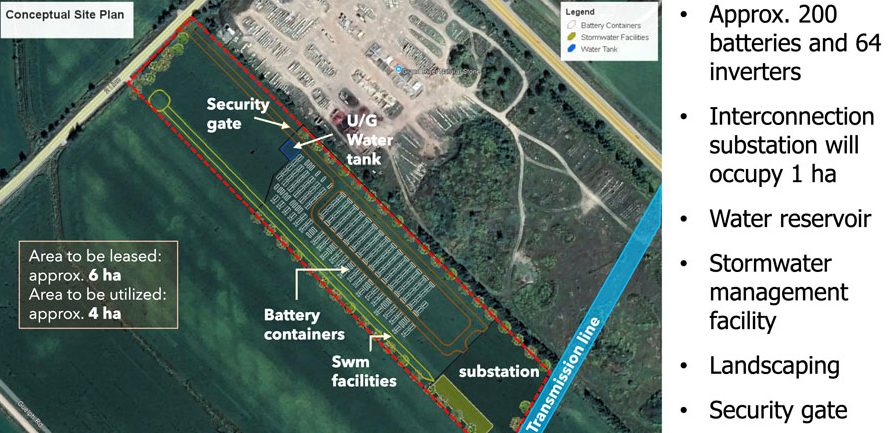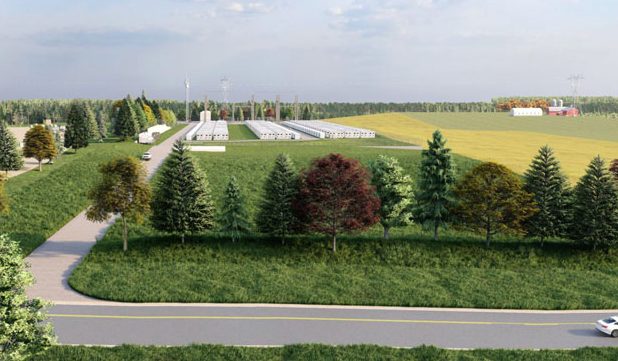FERGUS – The Aypa Power application to build a battery storage facility in south Fergus returned to council during a Nov. 25 public planning meeting, with many delegations expressing opposition to the proposed facility.
The prime concerns raised by delegates were: the risk of fire, contamination of soil and ground and surface water, and how to restore the land to prime agriculture when the 25-year lease is up.
The proposal is for a battery energy storage system (BESS) at 6235 Guelph Street, which is currently an active farm just south of 2nd Line and west of Highway 6.
Aypa Power plans to lease six hectares of the 43-hectare property for 25 years, and then restore the property to farmland.
Four of the six hectares would house the substation and the battery storage containers, which look like sea cans.
The facility would be monitored remotely but occasionally maintenance crews would be on site.
The intent is to plant trees to shield the facility from view. There would also be a water reservoir to store water in the event of a fire, and a stormwater management pond.
The site is optimum because hydro transmission lines are directly south of the property.
Pierre Chauvin, a planner with MHBC Planning retained by Aypa, said there aren’t that many sites in the province with transmission lines that can handle the extra capacity the facility would transmit to the grid.
As the province prepares for growth and the electrification of vehicles, it needs more power, Chauvin said.
The Independent Electricity System Operator (IESO) has forecast that demand for electricity will increase by 60 per cent over the next 25 years and is awarding contracts to businesses that can help supplement the power grid.
Battery storage facilities collect extra electricity when it is produced, store it and transmit it to the grid during peak times, thus reducing reliance on natural gas to keep the system running.
This proposal would have capacity to store 211 megawatts of energy with approximately 200 batteries and 64 inverters.

Aypa Power is proposing a battery storage facility in south Fergus on 2nd Line. Council heard from the public on the matter at its Nov. 25 meeting. Image from council agenda
Chauvin noted the province updated its provincial policy statement in October and battery storage facilities are now allowed as an on-farm diversified use.
The site would still need a zoning change from the township – from prime agriculture to agriculture with a special provision – and an official plan amendment as a “special policy area” from Wellington County.
The provincial policy statement says battery storage systems can occupy 2% of the total lot area; this proposal would be about 10% and would also require a site specific regulation that would permit the extra size.
Aypa recently learned the proposal had been approved by the IESO and is keen to get the project moving forward.
Centre Wellington resident Anthia Millikin worried about fire safety, the amount of water that would be needed and the potential for toxic fumes and possible evacuation if a fire occurred.
The BESS proposal is immediately south of the South Fergus Secondary Plan recently approved by council, which would see 6,000 more residents abutting the property.
“This will impact the safety of residents,” said Millikin. “But is the community aware? We need more consultation. Other communities have said no. Please don’t be a willing host.”
Donna McCaw of Save Our Water was worried about fire and the risk of explosion and the toxic chemicals and gases coming off them.
And that contamination could eventually get into the groundwater, she feared.
“Contaminated groundwater would stay for years, and it moves to wetlands and farmland,” she cautioned.
Janet Harrop, past president of the Wellington Federation of Agriculture, noted that while the province has approved these types of operations on agricultural land, the federation does not agree.
She spoke of how difficult it is to restore soil to agricultural use after it has been compressed from holding heavy objects for 25 years.
“Soil is the lifeblood of the community,” Harrop said.
Councillor Jennifer Adams noted the site would supply 6% of IESO’s energy goal while the population of Centre Wellington is just 0.002% of Ontario’s population, which she considered a disproportionate burden for the municipality.
Fire Chief Tom Mulvey said the department is researching how to manage BESS fires but seemed confident a fire safety plan could be created.
No decisions were made at the meeting. The matter will return to council at a future date.



